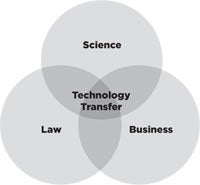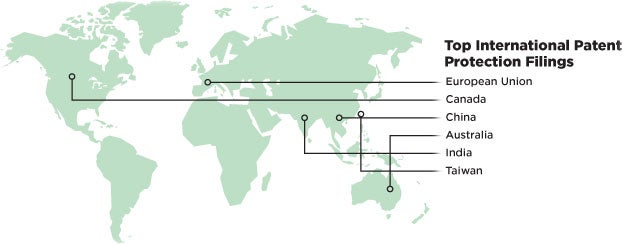Going Public
The OTT team brings UCF discoveries to the marketplace through intellectual property protection, marketing and licensing processes. The office connects UCF researchers and their innovations with companies and entrepreneurs to take the technology to market.

| Biofuels | Disease Detection |
| Bioimaging | Disease Therapies |
| Clean Technology | Nanotechnology |
| Computer Vision and Imaging | Optics and Lasers |
| Defense | Vaccines |
Research

When new faculty arrive, they begin working with students, collaborating with other researchers and partnering with industry.
Many researchers hit the ground running and soon reach out to federal, state and industry partners to fund their projects. The competition for funding is fierce.
Because ideas are often evaluated on scientific and commercial value, it’s particularly satisfying to receive funding. With funding, intensive research begins. Public and private funding agencies are getting to know UCF and the quality of its research.
- National Science Foundation
- National Institutes of Health
- Lockheed Martin Corp.
- Florida Department of Education
- U.S. Army Research, Development and Engineering Command
Once a scientist has solidified their hypothesis, made their discovery and is ready to publish their discovery, it’s time to record and protect the intellectual property. The invention disclosure is reviewed by a team of experts at the OTT to assess the viability of a patent application and commercial potential.
The scientist has one year to the day to further substantiate their innovation’s claims and file a nonprovisional patent application.
Protect
The OTT works with the researcher and patent attorneys to fulfill the U.S. nonprovisional patent application requirements. UCF may also file for international protection during this time.

It may take from 18 to 36 months to apply and receive the patent protection from the U.S. Patent Office or from other national and regional authorities.
UCF now owns a U.S. issued patent and possibly, if elected, a patent granted by another national or regional authority. For products or methods that have strong commercial potential, UCF may invest up to $100,000 to expedite market readiness.
Promote
The OTT reaches out to potential partners to detail how UCF’s new product could increase revenue, reduce expenses and/or avoid future costs.
UCF authorizes a licensee who may be a research sponsor, an industry partner, a government agency or a venture capital firm to use its intellectual property. Researchers may also launch their own spinout company and execute a license.
Commercialize
| 3 | College of Engineering and Computer Science |
| 2 | College of Optics and Photonics |
| 2 | College of Sciences |
| 1 | The Burnett School of Biomedical Sciences |
| 1 | Florida Solar Energy Center |
| 1 | Institute for Simulation and Training |
| 1 | NanoScience Technology Center |
The industry partner must now design, develop and deliver the product.
> $200K
License fees and royalties accrue when the innovation enters the marketplace. Companies grow, hire students, sell products and sponsor research. What started as an idea is now impacting the economy and UCF.
Nano Discovery Inc. is a medical research bioassay company founded by UCF Associate Professor Qun “Treen” Huo. Huo and her team developed a new technique involving gold nanoparticles to help detect cancer. She expects to commercialize this new technology to the biomedical research community in one to two years and to the diagnostic market in three to five years.
Garmor Inc. has developed a cost-effective method of producing high-quality graphene for use in aircraft automobiles and construction. Common applications for the allotrope of carbon include high-strength plastics used for automotive bumpers and bed liners, boat hauls, bridge components and custom-molded parts. The graphene technology was developed by Richard Blair, assistant chemistry professor at UCF, and Ph.D. student David Restrepo, ’08.